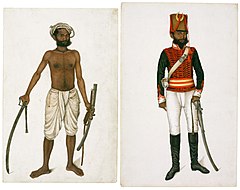
The Fraser Album is a collection of paintings commissioned by the British Indian civil servant William Fraser. It is considered among the greatest masterpieces of Company painting. This work is an important documentation of the Mughal empire towards its end.

The artwork covered life during the end of the Mughal era. The compendium comprises portraits of villagers, soldiers, holy men, dancing women, Afghan horse-dealers, ascetics, village of Rania and Indian nobles. Some of the noted Mughal painters, like Ghulam Ali Khan, his brother Faiz, and family worked on the Fraser Album, after financial support from the Mughal emperor diminished.
There are over 90 paintings and drawings in the album, which came to light in Fraser's papers only in 1979. Most were painted between 1815 and 1819. They are now dispersed.
Select works
Some of the notable Company portraits by Ghulam Ali Khan family, as part of the Fraser Album, are listed below:
- Three musketeers from Kurnal (c.1815-16)
- Four tribal warriors (c.1815-16)
- Salabat Bhatti and villagers at Rania (c.1815-16)
- Kala in uniform (c.1815-16)
- Kander Bakhsh, a dancing woman (c.1815-16)
- Ummee Chand in the uniform of Skinner's Horse (May 1819)
- A group of courtesans (c.1800-1825)
- The Emperor Bahadur Shah II enthroned (1838)
-
 Villagers Grinding Corn, Art Institute of Chicago
Villagers Grinding Corn, Art Institute of Chicago
-
 Elephant and driver, c. 1815–1819
Elephant and driver, c. 1815–1819
-
 Kala, the Sepoy, with Sabre Drawn and in Uniform. 1815–1816. The David Collection
Kala, the Sepoy, with Sabre Drawn and in Uniform. 1815–1816. The David Collection
See also
References
- Dalrymple, William (16 August 2003). "William Dalrymple on The Dehlie Book" – via www.theguardian.com.
- Schwendener, Martha (8 March 2012). "Scenes From a Dying Empire" – via NYTimes.com.
- "A Fraser Album Artist, 1815–1819 , The Bullock-drawn carriage of Prince Mirza Babur". www.christies.com.
- Goswami, BN (2011). "Masters of the "Company" Portraits". Artibus Asiae. Supplementum. 48. Artibus Asiae Publishers: 769–778. JSTOR 23223173 – via JSTOR.